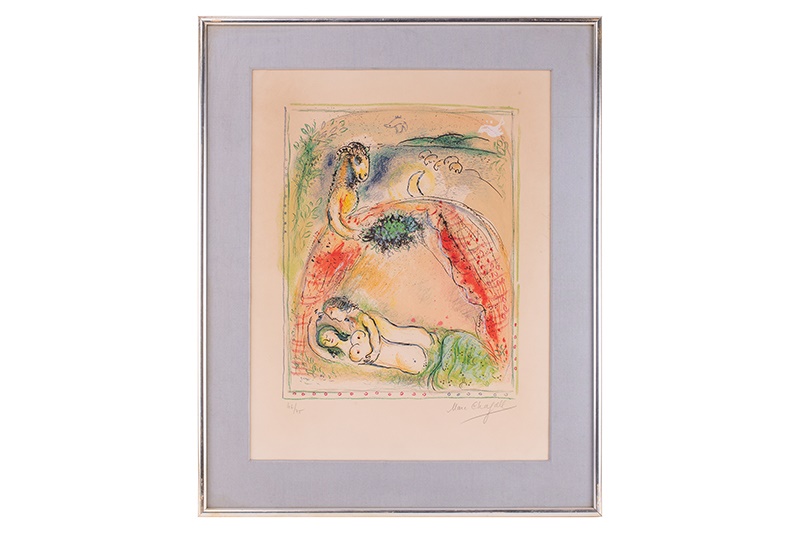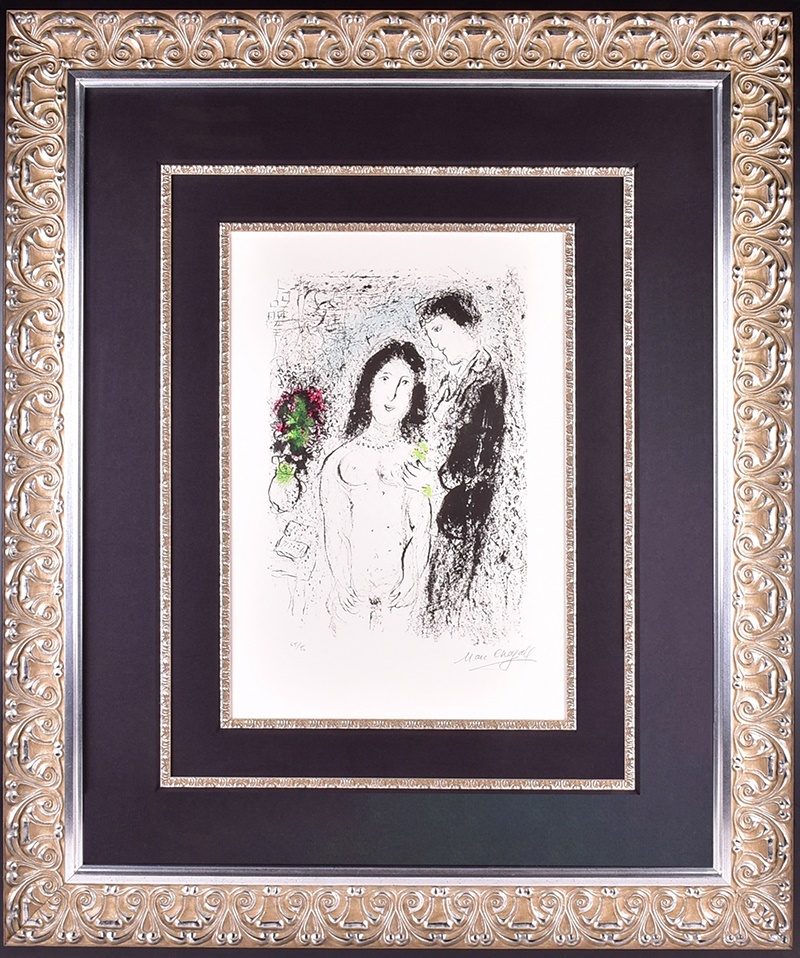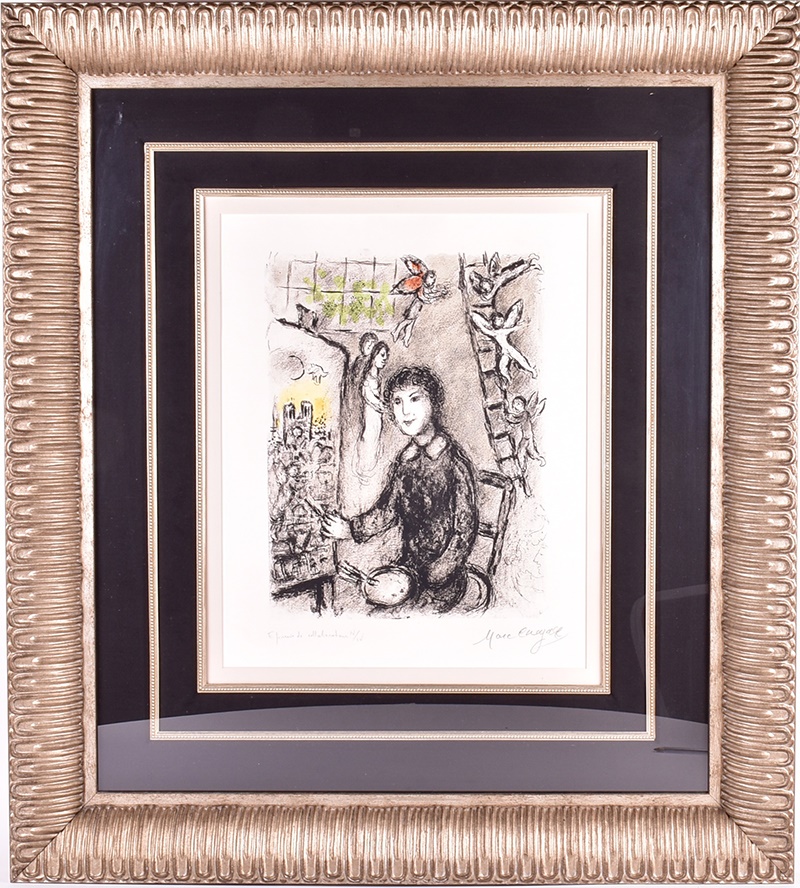A guide to the Work of Marc Chagall
One cannot fully appreciate the work of Marc Chagall without having an understanding of his life
06/02/2024
Pablo Picasso once remarked that “When Matisse dies, Chagall will be the only painter left who understands what colour really is".
One cannot fully appreciate the work of Marc Chagall without also having an understanding of his life, and how his extraordinary experiences no doubt shaped his work.
A Russian-French-Jewish artist, Marc Chagall was conceivably one of the most influential modern artists of the 20th century. An accomplished painter, book illustrator, stained-glass painter, stage set designer, tapestry maker and ceramicist, he left an indelible mark on the art world with his unique style and captivating works.
 Marc Chagall (1887-1985), 'Oh Happy Bridegroom'
Marc Chagall (1887-1985), 'Oh Happy Bridegroom'
On the 7th of July 1887 in the small town of Vitebsk, then part of the Russian Empire (modern day Belarus), Moyshe Segal was “born dead”. His distraught family failed to stimulate a response on his limp body with needles so in desperation they dunked him into a stone trough of cold water which finally prompted his wails. Chagall himself said he was a dreamer who never woke up.
Chagall’s early years were shaped by his Hasidic Jewish heritage and the vibrant folk-art traditions of his hometown. The visual representation of God’s creations is forbidden in Hasidism and as such, he grew up in a home completely devoid of any art or images. It was in high school that Chagall noticed another student drawing, he visited the library and started copying images which is when he decided he wanted to become an artist.
For a few months in 1906, Chagall studied at the studio of Yehuda (Yuri) Pen. Quickly realising that academic portrait painting was not his forte, he moved to the then capital St. Petersburg, where he studied at the Imperial Society for the Protection of Fine Arts and later under Léon Bakst at the Zvantseva School of Drawing and Painting. By 1907 he had begun painting naturalistic self-portraits and landscapes, drawing on his hometown of Vitebsk as his main source of inspiration – as it would be throughout his career. Although he didn’t enjoy the required study of classical art and would often collapse from hunger as he couldn’t afford to eat, it was in St. Petersburg that he discovered what would become one of the highlights of his vocation, in theatre set and costume design.
Marc Chagall (Russian/French 1887 - 1985), 'Heure Sereine'
In 1910 Chagall was able to move to Paris with the “financial support” of a sponsor in the Duma, Russia’s elective assembly. The sponsorship was modest which meant that he had to be frugal in those early days, surviving on half a fish daily and painting in the nude to avoid ruining his only clothes. Considered the very centre of the modern art world, he was on a mission to evolve his artistic style. He enrolled in the avant-garde Académie de La Palette and spent his spare time visiting galleries; he particularly enjoyed The Louvre. For a period of time, he lived in the infamous La Ruche (“The Beehive”), which housed a community of artists. He changed his name to the more French-sounding Marc Chagall and became an integral part of what would later be known as Ecole de Paris.
The Cubism movement dominated trends, Chagall was interested in the elements of this and incorporated some of them into his painting, but he found it too rational and geometric to fully commit. He learned a new technique, gouache and drew inspiration from The Fauves with his use of intense colour for emotional or mystical effect, which became one of his signature features. An example of his work during this period is “Paris Through the Window.”
After a very well received exhibition at the Sturm Gallery in Berlin, Chagall returned to Russia with the intention of only staying three months. This visit resulted in him being trapped indefinitely following the outbreak of the First World War, as well as the loss of all 200 works he had just exhibited.
During this period his works were dominated with thoughts of War and Death, his love for his fiancée Bella Rosenfeld, and his enduring nostalgia for Vitebsk. The worsening situation of the persecution of Jews and Nazi deportations led him to create a series of deeply religious paintings. “White Crucifixion” was the first of many compositions that feature Jesus as a Jewish martyr.
In 1915 Bella and Chagall were finally permitted to marry and she gave birth to their daughter. His painting Above the Town features the couple as a set of flying lovers, a motif that he would return to many times. Following the Bolshevik Revolution in 1917, Chagall was granted full citizenship rights in his own country, previously denied to Jews under the Tsarist regime. He was appointed Commissar for Art in Vitebsk, but ideological differences soon led to his resignation. He obtained a degree and busied himself with exhibitions, illustrating books, and designing murals and stage sets. By this time Chagall’s work had taken an increasingly fantastical turn with motifs of green cows and flying horses.
Marc Chagall (Russian,/French 1887 - 1985) 'Le peintre devant le tableau
In 1923 Chagall returned to Paris with Bella, where he met and befriended Ambroise Vollard who was an important art dealer. Vollard assisted Chagall with obtaining commissions and meeting other artists, including Pablo Picasso. The surrealism movement had taken centre stage and Chagall’s dreamlike works were receiving much praise. André Breton, founder of Surrealism, stated “With Chagall alone, the metaphor has made its triumphant return into modern painting” and “no work was ever so resolutely magical.”
In 1939 Nazi officials burned over five thousand modern artworks they considered to be degenerate, which included pieces by Chagall. The atrocities of the Second World War made France under Vichy rule a dangerous place for Jews and therefore Chagall. Fortunately, Alfred H. Barr, Jr., the director of the Museum of Modern Art, personally ensured that Chagall’s name was added to a list of artists who needed asylum from Nazi persecution. Chagall and his family relocated to America in 1941, arriving in New York the day after Germany invaded the Soviet Union.
During his time in New York, he forged friendships with other artists, held successful exhibitions, completed several major commissions as well as designing sets and costumes for the ballet “Aleko”. But it was a very dark time for Chagall, news of the obliteration of his hometown and the concentration camps were profoundly distressing, compounded by the untimely passing of his wife, Bella, in 1944. He found companionship with Virginia Haggard McNeil, who gave birth to his son in 1946. He received a retrospective at both New York’s Museum of Modern Art (MoMA) and the Art Institute of Chicago before returning to France in 1948, he never learned to speak English.
From the 1950s Chagall lived on the French Riviera, near Picasso, he adored the south of France. He travelled the world, throughout Europe to Palestine and the Middle East. He created etchings for works including The Bible, Gogol's “Dead Souls” and “La Fontaine's Fables”, which were later recognised as his finest illustrations. He continued to paint and achieved huge success with stained-glass windows, first completing a commission for Hadassah University Medical Center in Jerusalem, later the Peace Window for the UN Secretariat building. When Chagall was 80, he painted two gigantic murals for the lobby of New York’s Metropolitan Opera House, at Lincoln Center: The Sources of Music and The Triumph of Music.
Chagall worked right up until his death in 1985, indeed on the day he passed away he had been discussing a maquette painting for a tapestry commissioned by the Rehabilitation Institute of Chicago. Buried alongside his second wife, Vava, in the town of Saint Paul de Vence in Provence, Marc Chagall was the last surviving master of European Modernism.
Chagall's artistic style is characterised by dreamlike imagery, vibrant colours, and a whimsical blend of fantasy and reality. Throughout his career he incorporated elements from many schools of modern art, including Cubism, Fauvism, Symbolism, Surrealism, Orphism and Futurism. His paintings often feature floating figures, animals, and symbolic elements that reflect his personal experiences and emotions. What makes Chagall’s work so elusive is that it is uniquely his own. Some of Chagall's most famous works include "I and the Village," "The Birthday," "The Fiddler," and "The Green Violinist." These paintings showcase his distinctive style and ability to evoke emotion through visual storytelling.
Throughout his career spanning over seven decades, Marc Chagall made significant contributions to modern art, forging his creative path in spite of the many difficulties he faced. His work continues to captivate audiences around the world with its enchanting imagery and profound symbolism.
“I don’t know where he gets those images from; he must have an angel in his head.” – Picasso referring to the works of Chagall.
Do you have any work by Marc Chagall that you are considering selling?
With a global audience of over 10 million, Dawsons can achieve the best price for you.
Please get in touch with an expert valuer today for confidential sales advice.
We would be delighted to help:

